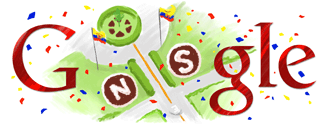 |
| Source: http://www.google.com/logos/2010/ecuador_ind10-hp.gif |
After nearly 300 years of Spanish colonization, Quito was still a small city of only 10,000 inhabitants. It was there, on August 10, 1809 (the national holiday), that the first call for independence from Spain was made in Latin America ("Primer Grito de la Independencia"), under the leadership of the city's criollos like Juan Pío Montúfar, Quiroga, Salinas, and Bishop Cuero y Caicedo. Quito's nickname, "Luz de América" ("Light of America"), comes from the fact that it was the first successful attempt to produce an independent and local government, although for no more than two months, that had an important repercussion and inspiration for the emancipation of the rest of Spanish America. Quito is also known as "La Cara de Dios" ("The Face of God") for the beauty of its religious colonial art and architecture cloistered in the amazing equatorial Andes landscape.




